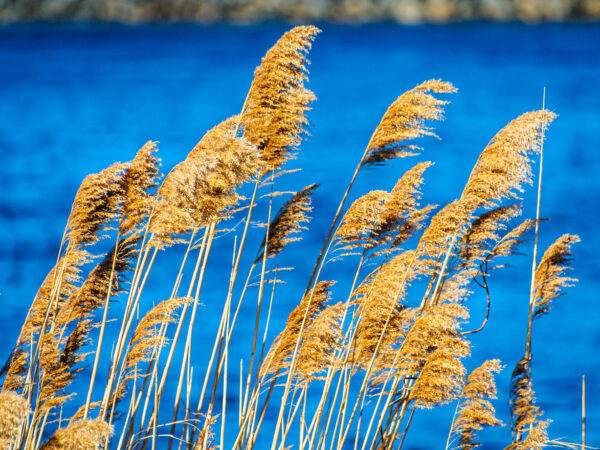Watch our Phragmites research video!

Phragmites (Phragmites australis)
Species at a Glance
Phragmites, also called the Common Reed, is a perennial grass that grows in tall stands and excludes other vegetation. While some strains of the species are native to North America, aggressive non-native strains have expanded throughout the United States, replacing much of the native reed.
Species Description
Phragmites form dense stands that can reach up to 15 feet high. Its leaves are broad and pointed and reach 20-61 cm (8-24 in) in length, and its flowers form bushy, fluffy clusters of fine hairs that grow on the seeds as they mature. Below ground, Phragmites form a dense network of roots and rhizomes several feet deep. Rhizomes can grow 10 ft (3m) or more in a single season. Differentiating between native and invasive forms of Phragmites can be very difficult, so DNA analysis is the most reliable method for identifying strains.
Native & Introduced Ranges
Although the species name ‘australis’ suggests that Phragmites is native to Australia, it is believed to have originated from the Middle East. Genetic research has shown three separate lineages occurring in North America: a native strain, a European strain, and one whose lineage is unclear. The invasive European strain was introduced in the 1800s, most likely in ballast material from transoceanic ships. It is now widespread throughout the lower 48 states and southern Canada.
Biology & Spread
Phragmites reproduces and spreads both by seed production and through vegetative fragmentation of rhizomes. Hundreds to thousands of seeds are produced each year which can spread to new locations by wind and water; although, seed viability can be highly variable. The extensive root and rhizome network allows this species to reproduce asexually as rhizomes break off and float downstream to new locations. Heavy machinery and equipment may also transport this species along roadsides between sites.
Habitat
Phragmites is unusual among grasses because it is able to colonize a wide range of habitats, including fresh and brackish waters. It is abundant along the borders of lakes, ponds, rivers, marsh communities, roadsides, and disturbed areas.
Impacts
Threat to Biodiversity
Introduced Phragmites is aggressive and quickly develops dense stands that take over wetland ecosystems, alter wetland hydrology, increase fire potential, and reduce wetland wildlife habitat. Phragmites consumes available growing space and pushes out other plants, including native strains of the species, quickly turning once biologically diverse wetlands into monocultures.
Economic Costs
Marsh restoration efforts to remove Phragmites can be very expensive and are often ineffective since this species can be quick to return after burning and chemical treatments.
Prevention & Control
While there are several treatments available for Phragmites, the effectiveness of a particular treatment depends on the area and extent of infestation. Areas with large, established populations are best restored using herbicide treatments. To increase the effectiveness of herbicides, applications should be timed when the plants will best translocate the herbicide to the rhizomes (late summer/early fall). Prescribed burning after the plant has flowered, alone or in combination with herbicide treatment, may also be effective; however, plants should not be burned in the spring or summer before flowering because this may stimulate growth. Cutting can help manage the size of the population, but timing is critical, and shoots must be properly disposed of to prevent sprouting in treated areas. Cutting 6-8 weeks prior to herbicide application and spraying the regrowth will increase the ease of the application and reduce the volume of herbicide required. A combination of all of these techniques is likely the most effective tool for eradication; however, frequent monitoring is needed to help prevent reinvasions.
References
Faulds, A. and Wakefield, K. Phragmites: A tale of two strains. Fact Sheet. <http://seagrant.psu.edu/publications/fs/Phragmites.pdf>.
Saltonstall, K. 2005. Fact Sheet: Giant Reed. Plant Conservation Alliance’s Alien Plant Working Group, Weeds Gone Wild. <http://www.nps.gov/plants/alien/fact/pdf/phaul.pdf>.
Swearingen, J. and Saltonstall, K. 2010. Phragmites Field Guide: Distinguishing native and exotic forms of Common Reed (Phragmites australis) in the United States. Plant Conservation Alliance, Weeds Gone Wild. <http://www.nps.gov/plants/alien/pubs/index.htm>.



